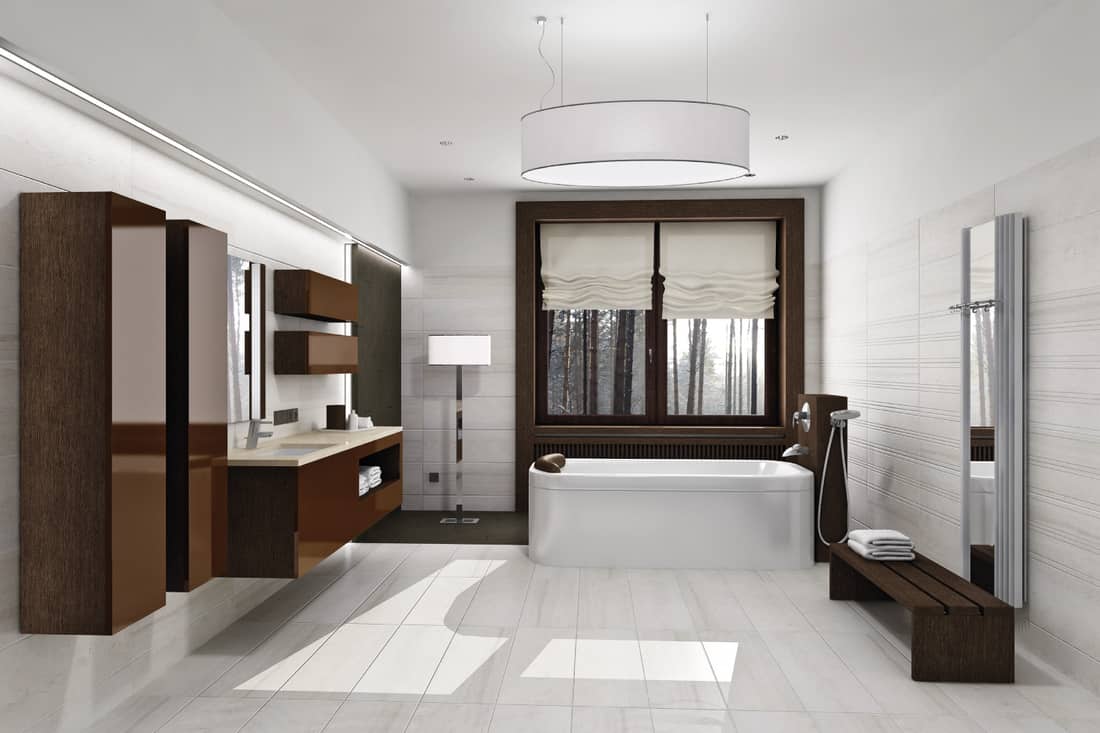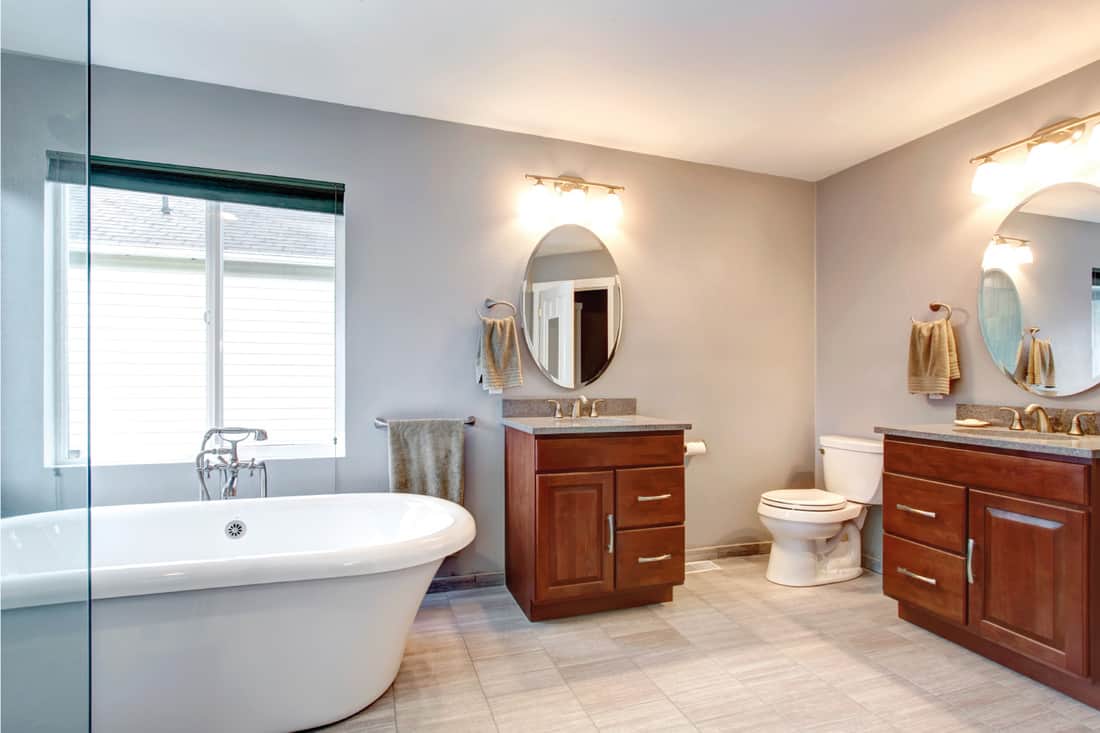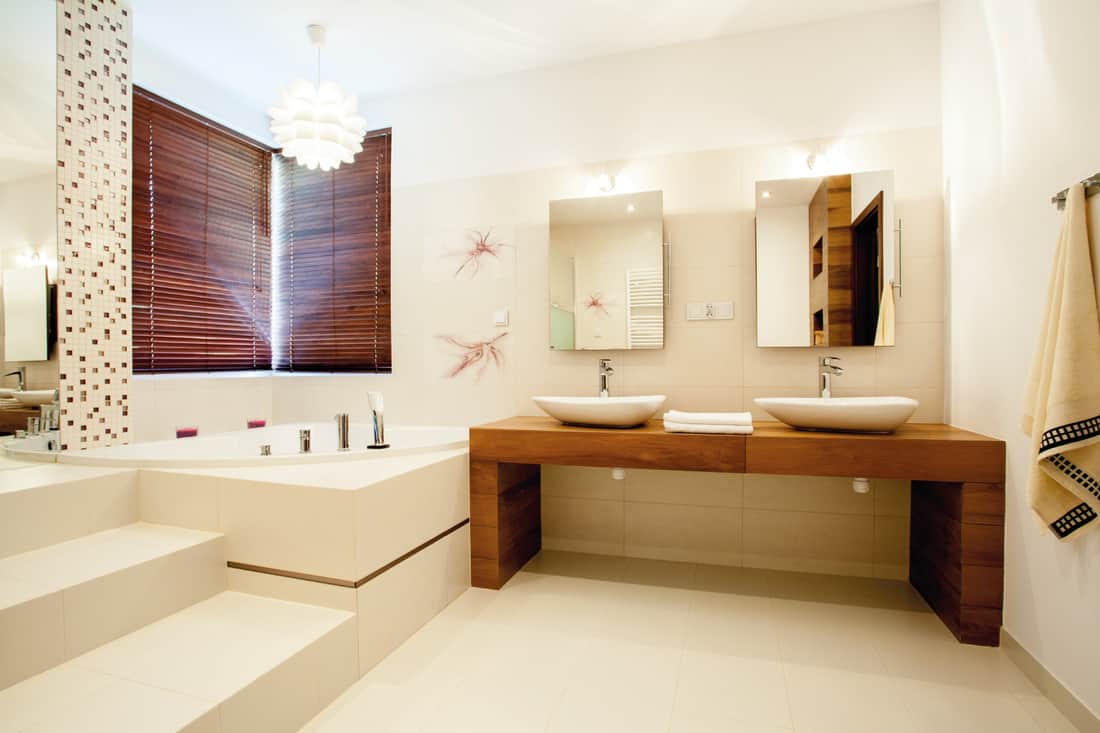When building a new home or planning a major remodeling, most people don’t place bathroom lighting at the top of their list of things to consider. So they often end up with a ceiling-mounted light/vent fan combo that doesn’t illuminate the room properly and leaves them struggling with tasks like shaving or applying makeup. The bathroom is the most challenging room in the house to light. It is small, requires different light types in specific spaces, and its mirrors reflect light in unusual ways. If you’re wondering how best to plan the lighting in your bathroom, we’ve done the research, and we have the answers for you!
Bathroom lighting works best when designed in layers, including ambient light, task lighting, and decorative lighting. Ambient light sets the mood of the room and is usually provided by a fixture mounted in the center of the ceiling. Task lighting — for jobs that require precision, like shaving or applying makeup — provides bright, shadowless illumination around the vanity mirror. And decorative lighting showcases art pieces, beautiful fixtures, or architectural details that add to the bathroom’s style.
In the remainder of this article, we’ll discuss the nuances of deciding where to install ambient, task, and decorative lighting, as well as the best types of fixtures for each. We’ll also examine the differences between using “warm” and “cool” white light in your bathroom, provide pointers on orienting light fixtures, and explain how to light a small bathroom effectively. Keep reading to learn all you need to know about bathroom lighting!
Where To Place Light Fixtures In Bathroom
The first rule of thumb for illuminating a bathroom is to make maximum use of any natural light available — windows, French doors, or skylights — for ambient illumination. Then add layers of light: additional ambient light to illuminate the whole bathroom; bright task lighting for the vanity, shower, and toilet areas; and decorative lighting to draw attention to particularly attractive features of the room.
Ambient Light
The ambient light in most bathrooms is supplied by a circular or rectangular fixture combined with a vent fan, mounted in the center of the ceiling. While this simple solution can work quite well, you may want to add some visual punch to the room instead of installing an unusual ceiling-mounted fixture, pendant lamp, or chandelier. Or, for a more diffuse ambiance, you could install cove lighting around the perimeter of the room.
Click here for this star-shaped bathroom light fixture on Amazon.
The color of your bathroom walls will affect the ambient lighting:
- If the walls are white or a pale hue, they will reflect the ambient lighting throughout the room, providing overall illumination.
- Darker walls will absorb most of the ambient light so that areas of the room illuminated by the task or decorative lighting will be visually emphasized. At the same time, the rest of the bathroom fades into shadow.

A chandelier mounted in the ceiling’s center and complementary sconces on the accent walls provide ambient illumination in this bathroom. These fixtures augment the period decor and cast a warm, yellow light throughout the room.

This modern bathroom makes excellent use of the natural light from the french doors and employs recessed can lighting for additional, muted ambient light, creating the feel of a quiet, luxurious sanctuary. Note the bar of fluorescent task lighting above the vanity mirror.

The bright, cool white bulbs in this ceiling-mounted fixture cast a precise ambient illumination over this modern bathroom. Fluorescent bar lights on either side of the vanity mirror provide task lighting.
Task Lighting
A bathroom needs bright, shadowless illumination above the vanity and over the shower. For safety reasons, recessed lighting is typically used above the shower. There is more flexibility in the type, style, and positioning of fixtures installed in the vanity area. To ensure enough illumination, use bulbs with a minimum 100-watt rating (24-26 watt compact fluorescent; 25-watt LED) for vanity task lighting.
Beside Vanity Mirror
Bright lighting on the vanity mirror’s sides provides shadowless illumination of the whole face for precision grooming tasks. The most common sources of task lighting are wall sconces or vertical bars of fluorescent light. Position task lighting 4″ – 6″ to each side of the mirror. To provide bright light without a blinding glare, all sconces that open upward should be placed with the top rim just above eye level; those that open downward should have their lower rims slightly below eye level.

In this small vanity area, wall sconces provide task lighting. The style and finish of the sconces complement the formal decor. The sconces’ openings point upward, and the top rim of the fixture is just above eye level so that the user enjoys bright task lighting without glare.
Click here for this bathroom wall sconce on Amazon.
Above Vanity Mirror
If you choose to illuminate your vanity from above, rather than from the side, place either a bar of lights or a series of sconces just above the mirror and angle them so that their light reflects off the mirror. This will ensure that the face of the person standing at the mirror is illuminated without shadows. Don’t use recessed ceiling lights to provide task lighting for the vanity, because the user’s face will be shadowed.

As an alternative to placing sconce task-lighting on either side of the vanity mirror, you may choose to install lights above the mirror, as demonstrated in the picture above. Note that these fixtures are angled toward the mirror.
Click here for farmhouse-style above-vanity lights on Amazon.
Decorative Lighting
Decorative lighting forms the third “layer” of ideal bathroom illumination. It serves to focus attention on specific areas of the room: artwork on the walls, an unusual tile mosaic, or particularly attractive bathroom fixtures. Decorative lighting fixtures are usually wall- or ceiling-mounted spotlights, directed to illuminate a particular, defined area on a wall. Sometimes the fixture itself makes a style statement while also lighting a selected piece of decor.

The decorative lighting in this bathroom highlights the framed photographs on the accent wall. The spotlight extends a small distance out from the wall and is angled to cast its illumination directly on the artwork.

Sometimes the light fixture itself provides decoration and style, as in the picture above. The spiny fixture adds interest to the room, highlights the luxurious spa tub, and provides muted, relaxing illumination for a long soak in the spa.
Click here for this bathroom spotlight on Amazon.
Is Warm White Or Cool White Better For Bathrooms?
Warm white lighting has a bit of a yellowish tone. It casts a relaxing, calming glow while providing enough illumination for tasks like bathing and dressing. Warm white bulbs are an excellent choice for ambient and decorative lighting fixtures, especially in bathrooms with traditional style.
Cool white mimics the crisp clear illumination of daylight, albeit sometimes with a minor blue tint. It is best for tasks that require precision, such as applying makeup, shaving, trimming hair, or plucking eyebrows. Cool white also reflects skin color more accurately than warm lighting does. Thus, many homeowners choose cool white light bulbs for their task lighting, particularly around the vanity.
Click here for cool white fluorescent light bulbs for the bathroom on Amazon.
What Is The Best Lighting For A Small Bathroom?
If you have a small bathroom, you face the additional challenge of effectively lighting the space without completely overwhelming it. The best choice for ambient lighting in small bathrooms is recessed ceiling lights, which provide illumination without taking up valuable space. You may also consider installing strip lighting under your bathroom cabinets and shelves to increase the illumination in the room. You will probably decide not to use decorative lighting at all, and you may look for unconventional sources of task lighting.
In many small bathrooms, there is no task lighting at all, leaving users to rely on ambient ceiling lights that don’t properly illuminate their faces. Because of the limited wall space, there may not be room to place light fixtures around or above the vanity mirror; so, as an alternative, consider installing a mirror or medicine cabinet with the light built in.
Click here for this lighted bathroom vanity mirror on Amazon.
Should Bathroom Light Fixtures Be Pointed Up Or Down?
Some bathroom light fixtures can be installed so that the open endpoints either up or down. A general rule of thumb is that, if the fixture is providing ambient light, the opening should point upward; if it is providing task lighting, the opening should point down. Like most rules, this one has some exceptions. For example, sconces placed on either side of the vanity mirror can point up or down, depending on aesthetic needs.
Click here for a reversible bathroom wall sconce on Amazon.
Do Hardware And Light Fixtures Need To Match?
In choosing light fixtures for your bathroom, it’s important to consider all the details — including whether the finish of your fixtures works well with the rest of the hardware in the room. Think about faucets, door handles, cabinet hardware, mirrors, and any other metallic details. Although it’s not necessary that all of them have the same finish, they must be all complimentary. For example, if the rest of your bathroom hardware is a mix of chrome and black, don’t install a light fixture with a brass or gold hue.
Other Considerations
There are a few more factors you should keep in mind as you’re planning what lighting fixtures to purchase for your bathroom.
- All lights in the bathroom should be “damp-rated” (meaning that they are safe to use in moist areas); those above the shower need to be “wet-rated” (waterproof) because they come into direct contact with water.
- Keep in mind that the size of your bathroom light fixtures matters: if they are too large, they can overwhelm the space, and if they are too small, they may appear inadequate for their task.
- Consider installing dimmer switches, especially for your task lighting: turning down the brightness when you don’t need it can make the bathroom a more relaxing and comfortable place.
In Closing
Choosing the most effective lighting for your bathroom can be a challenging task. But if you do it right by layering soft ambient light, bright task lighting, and well-placed decorative illumination, you can turn your bathroom into a masterpiece of style and function. Pay attention to the details and build a plan that fits the specific needs of your bathroom’s shape, size, and style, and you can enjoy it for years to come!






